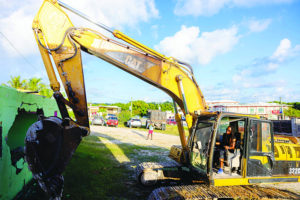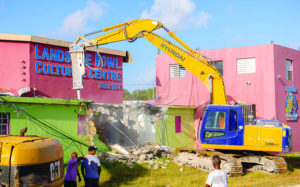
 The Landsome Bowl Cultural Centre, built on one of Anguilla’s most significant historic landmarks, was razed to the ground over the weekend of February 17th and 18th as demolition teams scurried to bulldoze the facility which had for almost 50 years been the venue for a multitude of cultural events in Anguilla.
The Landsome Bowl Cultural Centre, built on one of Anguilla’s most significant historic landmarks, was razed to the ground over the weekend of February 17th and 18th as demolition teams scurried to bulldoze the facility which had for almost 50 years been the venue for a multitude of cultural events in Anguilla.
In particular, the Landsome Bowl, commonly called “The Village”, was the hub of the Summer Festival activities since its commissioning in 1975. Now, its demolition has made way for the construction of a new and improved state-of-the-art facility which would be fit-for-purpose in all things cultural.
Historically, the Landsome Estate was the site upon which the pre-revolution St. Kitts-based administration had constructed Anguilla’s Government House, the administrative headquarters of the local Government and the residential abode for the ruling Warden.
According to Colville Petty’s work, “Anguilla’s Battle For Freedom 1967 – 1969”, due to the Warden’s refusal to leave Anguilla during the 1967 Revolution, the massive building known as the “Warden’s House” was set alight in the early morning hours of Wednesday, March 8th 1967, and destroyed by fire. Rather humorously, the Warden frantically escaped the burning building in his pajamas.
The deliberate destruction of the Warden’s House made room for the construction of the Landsome Bowl Cultural Centre which was dedicated in 1975.
The tearing down of the old Landsome Bowl was dubbed “A Jollification Demolition”. And though jollifications are generally cultural tasks taken on by a number of workers with enthusiastic, cheerful spirits, still many who stood and witnessed the demolition were somewhat saddened to say goodbye to the place where so many cultural memories were crafted. Nevertheless, they looked beyond the demise of the old with hopes towards the erection of a new facility in the not-too-distant future.
Speaking about the tearing down of the old facility on Friday February 16th, the day prior to its actual demolition, the Honourable Minister of Education and Social Development, Ms. Dee-Ann Kentish-Rogers, who has responsibility for culture, remarked: “We are inviting the public to come out tomorrow and witness the knocking down of something that is very important to all of us. In the morning (Saturday), we will give persons a last chance to experience the final feel of the old facility. I have heard a few persons say they feel like they are going to cry, and I can understand the sentiments.”
She further mentioned that the Landsome Bowl Cultural Center, as it was, was not really able to host daytime events, and it was rather limited in terms of having cultural activities staged there. “In fact,” she noted, “the Centre is mainly used during the carnival months at night time. So, we will be erecting a new Centre which would be the hub of all cultural activities, not just for nighttime events, nor not just to facilitate the June to August Summer Festival events, but a facility that would be used all year round in order to develop the spirit of culture on a regular basis.” She said then that we are moving forward with a facility which speaks to the past and heralds the future for the opportunities that would become available.
Minister Kentish-Rogers commented on Monday: “On the weekend, we had a demolition jollification which we thought was a very useful way to reflect the jollification efforts of the community. It was through the means of community jollification that the building, the Centre was done in the first place.”
She continued: “The Landsome Bowl Cultural Centre initially was not built in one go. During its construction phases, many persons from the community had come together from time to time to build it up to what it was. So, in view of those memories, we thought jollification the most appropriate way to bring it down – to bring the community back together to say goodbye to the building. We endeavoured to pay respects to everyone’s memories of the Cultural Centre.”
Persons who had performed on the cultural stage were on hand to reflect on their memories of what made Landsome Bowl so meaningful to them. Most of them were interviewed by Ms. Gleneva Hodge, a leading community activist and radio hostess.
She spoke to one such performer, Mr. Felix Fleming, a renowned Anguillian playwright, who had dramatized a number of plays performed on the Landsome Bowl stage.
“I am feeling great this morning because I am seeing in my time the prospects of something new on the horizon for Anguilla’s culture,” Mr. Fleming commented. “We have been looking forward to this for a long time.”
He recounted one play that he produced for Landsome Bowl’s stage called “Master of Carnival”. He said it was quite appropriate to dramatize that play in ‘The Village’ at the time that he did. “It was not staged in a theatre facility, per se, but I hope this coming new Centre would be able to accommodate such plays more efficiently,” he said.
His wife, Mona, was also present with him during the demolition. She had been very instrumental in designing and crafting outfits for Carnival Queen contestants and other young ladies who had graced the stage of the Landsome Bowl for Summer Festivals over several years. She remarked. “I am happy, because today I see we are getting something new and something better.”
“When we were working in this ‘Carnival Village’ back in the early nineties,” she reflected, “we had worked in what we can say was ‘a shack’…My husband Felix did a lot to make it look better on the inside. He brought stuff from home just to accent the interior. So I am happy that we are going to get something new now.”
One of Anguilla’s leading Carnival pioneers, Dr. Oluwakemi Linda Banks, is no stranger to the cultural art form. In fact, she was one of the young ladies who had contested for what was to be the interrupted Statehood Queen Show in 1967 during the era of the St. Kitts-based administration. As a teenager then, young Linda Banks had practiced her stage moves in the aforementioned Warden’s House on the very spot where the now demolished Landsome Bowl Cultural Centre had stood.
During her interview with Gleneva, on the demolition grounds, Dr. Banks said: “This was the place upon which the Warden’s House stood. It was burnt out during the Anguilla Revolution. Some years later, we had wanted to expand the Summer festivities from what was just the August Monday Bazaar held on the Park.
“At that time, in the mid nineteen-seventies, it was just a mini-carnival of sorts, and desiring expansion, someone suggested that we develop the site of the old Warden’s place. We came down here, looked around, and the vision for the Landsome Bowl Cultural Centre was born.”
Dr. Banks has written an in-depth account of the early beginnings of carnival in Anguilla relative to the Landsome Bowl Cultural Centre. (That account is presented elsewhere in this issue of The Anguillian. )
The Government of Anguilla has partnered with the Dart Group, the owners of Four Seasons Resort, which will be undertaking the entire funding of the new facility’s construction as their social contribution to the community of Anguilla.
The architectural design of the new Landsome Bowl Cultural Centre was done free of charge by the Ministerial Assistant in the Ministry of Finance, Mr. Courtney Morton, with the assistance of Mr. Daryl Richardson and Mr. Kaseem Forde.








